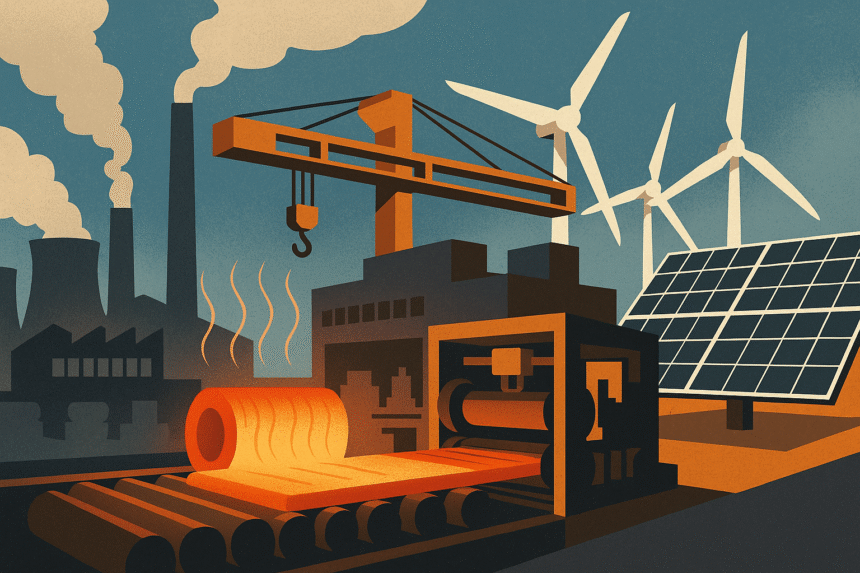As Europe intensifies efforts to meet climate targets, industrial giants such as Thyssenkrupp are grappling with the enormous task of transitioning to cleaner energy sources. The shift—though environmentally necessary—presents significant operational, financial, and logistical challenges that are reshaping how factories function across the continent.
At the heart of the transformation is Thyssenkrupp’s Hohenlimburg steel processing plant in western Germany. The plant, which consumes as much energy as a small city, has begun sourcing up to 40% of its electricity from a nearby wind farm composed of four 160-meter turbines. This move makes it the first of its kind in Germany to tap directly into wind power for its industrial operations.
Wind and Solar: Promise and Limitations
While Hohenlimburg’s location is well-suited for wind energy, Thyssenkrupp’s CEO Dennis Grimm warns that this model is not replicable everywhere, especially given regulations that prevent industrial power plants from being located more than 5km away from factories.
For instance, the company’s larger coal-fired steel plant in Duisburg would require more than 80 wind turbines to meet its energy demands—a scale considered infeasible under current German law. The long-term goal is to replace coal-based processes with hydrogen-based iron reduction and eventually shift to electric arc furnaces, which would drastically increase electricity needs to the level of “hundreds of turbines,” according to Grimm.
Cost Pressures and Market Volatility
The economic burden of the green transition is a top concern. In 2024, electricity prices for energy-intensive industries in Germany reached $92 per megawatt-hour, compared to $70 in China and $45 in the US, according to the International Energy Agency. These disparities are putting European manufacturers at a disadvantage, especially as they compete with lower-cost imports from China and face tariffs in the US.
In response, some companies are adopting flexible production strategies, adjusting their operating hours to coincide with times when electricity prices on spot markets fall—sometimes even below zero, during periods of excessive wind or solar generation.
“If you can shift even 1% of production to these sub-zero pricing periods, the savings can be enormous,” said Domenico Franceschino of energy trader Axpo.
A New Role for Power Purchase Agreements
Companies are also turning to long-term renewable energy contracts, known as Power Purchase Agreements (PPAs). According to BloombergNEF, the volume of renewable energy sold through such agreements in Europe grew 35% in the past year. While some PPAs guarantee a consistent energy supply regardless of weather fluctuations, others shift the risk of supply volatility onto the buyer.
“It’s not a one-size-fits-all solution,” said Sonia Thimmiah, Senior Director of Global Sustainability at Heineken, which aims to source all its electricity from renewables by 2030.
Hydrogen as a Long-Term Solution
Beyond wind and solar, green hydrogen is viewed as a critical future energy source for heavy industry. Thyssenkrupp had to pause a green hydrogen procurement tender earlier this year due to high costs and a sluggish market rollout. Still, the company plans to replace natural gas with hydrogen in its furnaces at both Hohenlimburg and Duisburg when economically viable.
Thyssenkrupp has stated that it is in ongoing discussions with the German and EU governments to accelerate its hydrogen transition plans. Using hydrogen—even in combination with natural gas—could result in significant emissions reductions compared to traditional coal-based processes.
Workforce and Restructuring
As part of broader changes, Thyssenkrupp announced it would cut 5,000 jobs in its steel division by the end of the decade. This move is part of a restructuring strategy aimed at making the group more agile and attracting external investment to fund clean energy transitions.
Despite these pressures, company executives remain committed to long-term sustainability goals.
“All of us are committed to carbon neutrality — there is no other view on that,” said Grimm.
Government Support and Industry Outlook
Germany’s energy ministry has acknowledged the impact of high energy costs on industrial competitiveness and is working to lower electricity prices and expand the hydrogen economy. However, industry leaders continue to urge for more pragmatic planning, warning that energy transition goals must remain grounded in economic and technical reality.
As Europe seeks to balance its green ambitions with the practical needs of industry, companies like Thyssenkrupp are emblematic of both the challenges and opportunities that lie ahead.








